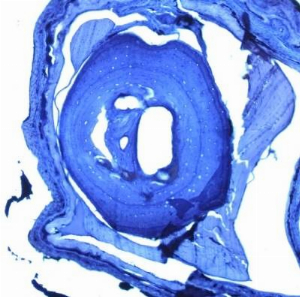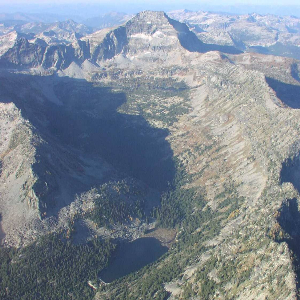Search ARMI Database
Search term(s)
Contribution Number
Search Results
879 record(s) found.
Papers & Reports A Protocol for Aging Anurans Using Skeletochronology
Authors: Brome McCreary; Christopher A Pearl; Michael J Adams
Date: 2008 | Outlet: US Geological Survey Open-File Report 2008-1209
Age distribution information can be an important part of understanding the biology of any population. Age estimates collected from the annual growth rings found in tooth and bone cross sections, often referred to as Lines of Arrested Growth (LAGs), have been used in the study of various animals. In this manual we describe in detail all necessary steps required to obtain estimates of age from anuran bone cross sections via skeletochronological assessment. We include comprehensive descriptions of how to fix and decalcify toe specimens (phalanges), process a phalange prior to embedding, embed the phalange in paraffin, section the phalange using a microtome, stain and mount the cross sections of the phalange and read the LAGs to obtain age estimates.
Papers & Reports Decreased winter severity increases viability of a montane frog population
Authors: Rebecca M McCaffery; B A Maxell
Date: 2010 | Outlet: Proceedings of the National Academy of Sciences, USA 107: 8644-8649
Many proximate causes of global amphibian declines have been well documented, but the role that climate change has played and will play in this crisis remains ambiguous for many species. Breeding phenology and disease outbreaks have been associated with warming temperatures, but, to date, few studies have evaluated effects of climate change on individual vital rates and subsequent population dynamics of amphibians. We evaluated relationships among local climate variables, annual survival and fecundity, and population growth rates from a 9-year demographic study of Columbia spotted frogs (Rana luteiventris) in the Bitterroot Mountains of Montana. We documented an increase in survival and breeding probability as severity of winter decreased. Therefore, a warming climate with less severe winters is likely to promote population viability in this montane frog population. More generally, amphibians and other ectotherms inhabiting alpine or boreal habitats at or near their thermal ecological limits may benefit from the milder winters provided by a warming climate as long as suitable habitats remain intact.Amore thorough understanding of how climate change is expected to benefit or harm amphibian populations at different latitudes and elevations is essential for determining the best strategies to conserve viable populations and allow for gene flow and shifts in geographic range.
Papers & Reports Making great leaps forward in herpetology: accounting for detectability in field studies
Authors: M J Mazerolle; Larissa L Bailey; W L Kendall; J A Royle; S J Converse; J D Nichols
Date: 2007 | Outlet: Journal of Herpetology 41: 672-689
Papers & Reports State-wide assessment of status, predicted distribution, and landscape-level habitat suitability of amphibians and reptiles in Montana
Authors: B A Maxell
Date: 2009 | Outlet: Dissertation. Missoula: University of Montana
The information gathered during field inventories was combined with other existing information and used in maximum entropy modeling to predict state-wide distribution and habitat suitability for all of Montana’s amphibians and reptiles.
Papers & Reports Are two methods better than one? Area constrained transects and leaf litterbags for sampling stream salamanders
Authors: S D Mattfeldt; Evan HC Grant
Date: 2007 | Outlet: Herpetological Review 38: 43-45
Papers & Reports Monitoring multiple species: estimating site occupancy, local colonization, extinction and exploring the efficacy of a monitoring program.
Authors: S D Mattfeldt; Larissa L Bailey; Evan HC Grant
Date: 2009 | Outlet: Biological Conservation 142: 720-737
Papers & Reports Osteopilus septentrionalis: Diet
Authors: A J Maskell; Hardin J Waddle; Kenneth G Rice
Date: 2003 | Outlet: Herpetological Review 34: 137
Describes the predation of a Florida Brown Snake by the invasive Cuban Treefrog in south Florida.
Papers & Reports Occupancy estimation and modeling for rare and elusive populations
Authors: Darryl I MacKenzie; J A Royle; J A Brown; J D Nichols
Date: 2004 | Outlet: Thompson WL, editor. Sampling rare or elusive populations. Washington, DC: Island Press 149-172
Papers & Reports Designing efficient occupancy studies – General advice and allocating survey effort
Authors: Darryl I MacKenzie; J A Royle
Date: 2005 | Outlet: Journal of Applied Ecology 42: 1105-1114
Papers & Reports Improving inferences in population studies of rare species that are detected imperfectly
Authors: Darryl I MacKenzie; J D Nichols; N Sutton; K Kawanishi; Larissa L Bailey
Date: 2005 | Outlet: Ecology 86: 1101-1113
Papers & Reports Occupancy estimation and modeling: Inferring patterns and dynamics of species occurrence.
Authors: Darryl I MacKenzie; J D Nichols; J A Royle; K A Pollock; Larissa L Bailey; J E Hines
Date: 2005 | Outlet: Academic Press.
Papers & Reports Estimating site occupancy rates when detection probabilities are less than one
Authors: Darryl I MacKenzie; J D Nichols; G B Lachman; S Droege; J A Royle; C A Langtimm
Date: 2002 | Outlet: Ecology 83: 2248-2255
Papers & Reports Estimating site occupancy, colonization and local extinction when a species is detected imperfectly
Authors: Darryl I MacKenzie; J D Nichols; J E Hines; M Knutson; A B Franklin
Date: 2003 | Outlet: Ecology 84: 2200-2207
Papers & Reports Occupancy as a surrogate for abundance estimation
Authors: Darryl I MacKenzie; J D Nichols
Date: 2004 | Outlet: Animal Biodiversity and Conservation 27: 461-467
Papers & Reports Investigating species co–occurrence patterns when species are detected imperfectly
Authors: Darryl I MacKenzie; Larissa L Bailey; J D Nichols
Date: 2004 | Outlet: Journal of Animal Ecology 73: 546-555
Papers & Reports Assessing the fit of site occupancy models
Authors: Darryl I MacKenzie; Larissa L Bailey
Date: 2004 | Outlet: Journal of Agricultural, Biological, and Environmental Statistics 9: 300-318
Papers & Reports Pre-hibernation energy reserves in a temperate anuran, Rana chensinensis, along a relatively fine elevational gradient
Authors: X Lu; B Li; Y Li; X Ma; Gary M Fellers
Date: 2008 | Outlet: The Herpetological Journal 18: 97-102
Papers & Reports Establishing Causality in the Decline and Deformity of Amphibians: The Amphibian Research and Monitoring Initiative Model
Authors: E E Little; C M Bridges; G L Linder; Michelle D Boone
Date: 2003 | Outlet: Linder GL, Krest S, Sparling D, Little EE, editors. Multiple stressor effects in relation to declining amphibian populations. West Conshohocken, PA: ASTM International. 263-
Papers & Reports Multiple causes for the malformed frog phenomenon
Authors: Michael J Lannoo; D R Sutherland; P M Jones; D Rosenberry; R Kalver; D Hoppe; P TJ Johnson; K B Lunde; C Facemire; J Kapper
Date: 2003 | Outlet: Linder GL, Krest S, Sparling D, Little EE, editors. Multiple stressor effects in relation to declining amphibian populations. West Conshohocken, PA: ASTM International. 233-262
Papers & Reports Introduction, part 2 Species accounts
Authors: Michael J Lannoo; A L Gallant; Priya Nanjappa; Laura Blackburn; R Hendricks
Date: 2005 | Outlet: Lannoo M, editor. Amphibian declines: the conservation status of United States species. Berkeley: University of California Press 351–380


